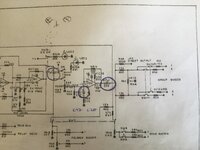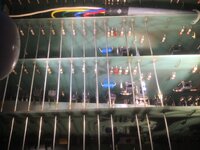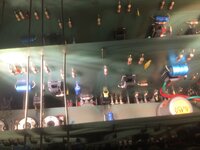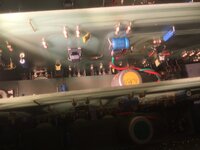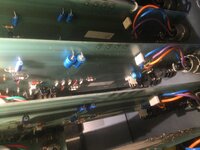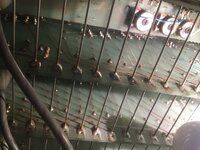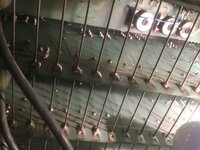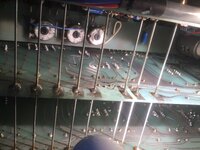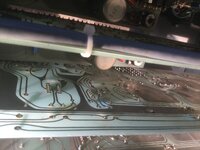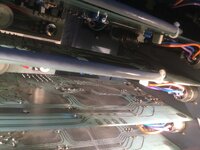Hi everybody,
I recently purchased a vintage recording console, the Hudson CS 1604 DO which was made in France in the early 70's and was widely used in radio at that time. Probably most of you won't have heard about that console because it's really niche, but it's been giving me some kind trouble lately. The symptoms are very reminiscent of the issue I had in the past year with my Tascam M512, that fellow member Sweetbeats helped me fix in an incredibly generous way.
Here's what's happening :
- On 5 of the 16 channels, the MIC input doesn't work. There is nothing happening on the VU meter until the GAIN knob is almost fully clockwise, at which point the OVERLOAD LED starts lightning up and the VU meter goes ballistic, he channel even outputs a very high pitched screeching noise. The LINE ins work on all channels. One of the most commonly known issues with that console is that the INSERT TRS jack input gets oxidized and shorts the connection. I have been advised to put some contact cleaner inside the plug and plugging a cable in and out of it several times. As of now, this hasn't changed anything.
Here's what I have already tried, without success :
- I have replaced all of the OP amps on the faulty channels, which didn't change anything.
- Signal does come out of the INSERT jack when I plug my headphones in it, it's very faint, but it's just as faint on all the other channels.
- One thing that I have done is I have unsoldered the 4 cables of the INPUT TRANSFORMER from the faulty circuit board, and switched it with the nearest channel which I know is working properly. The problem follows the transformer : the channel that didn't work previously now works perfectly, and vice-versa.
I bought the console mainly for it's input transformers which were made by a very reputable French company that built very high end transformers and microphones from the 1930's to the 1970's. That company was called "Melodium" and was responsible for one of the best ribbon microphone ever made, the Melodium 42b. It surpasses the RCA 44 in signal to noise ratio, output, and has a wider frequency response. I own two of them and they really are unreal.
My assumption is that the TRANSFORMERS are dead on all of the 5 faulty channels which really bothers me as you can imagine. But as all of my engineer friends have pointed out, it is very unlikely to blow an input transformer like that, let alone 5 !! It is very difficult if not completely impossible to find vintage replacements for these. Should I just buy replacement transformers (Neutrik makes very cheap ones https://www.thomann.de/fr/neutrik_nte_103_audio_uebertrager.htm?gclid=Cj0KCQjwj7CZBhDHARIsAPPWv3dmVU6tDdBysO4AJWlQsQiRPptuPvUfV2O4SoyMsiSnf4Z1Zk2p7LAaArShEALw_wcB but I guess they won't sound the same at all...).
How should I test the transformers ? Is there a way to know right away if they work or not by using a multimeter ? This is pretty much the only measuring tool that I have, and I really don't know how to use it properly.
Is there a step that I might be missing ? Something other than the transformer which might be the issue here ? The console is very hard to work on, all of the busses are hard wired, I would have to desolder everything to have access to one channel card...I have had a quick look at the electrolytic capacitors, which all seem fine to the naked eye, but then again that may not mean they are functioning properly.
What are your thoughts on this ? I have attached the schematics of the console.
Thanks very much.
Louis
I recently purchased a vintage recording console, the Hudson CS 1604 DO which was made in France in the early 70's and was widely used in radio at that time. Probably most of you won't have heard about that console because it's really niche, but it's been giving me some kind trouble lately. The symptoms are very reminiscent of the issue I had in the past year with my Tascam M512, that fellow member Sweetbeats helped me fix in an incredibly generous way.
Here's what's happening :
- On 5 of the 16 channels, the MIC input doesn't work. There is nothing happening on the VU meter until the GAIN knob is almost fully clockwise, at which point the OVERLOAD LED starts lightning up and the VU meter goes ballistic, he channel even outputs a very high pitched screeching noise. The LINE ins work on all channels. One of the most commonly known issues with that console is that the INSERT TRS jack input gets oxidized and shorts the connection. I have been advised to put some contact cleaner inside the plug and plugging a cable in and out of it several times. As of now, this hasn't changed anything.
Here's what I have already tried, without success :
- I have replaced all of the OP amps on the faulty channels, which didn't change anything.
- Signal does come out of the INSERT jack when I plug my headphones in it, it's very faint, but it's just as faint on all the other channels.
- One thing that I have done is I have unsoldered the 4 cables of the INPUT TRANSFORMER from the faulty circuit board, and switched it with the nearest channel which I know is working properly. The problem follows the transformer : the channel that didn't work previously now works perfectly, and vice-versa.
I bought the console mainly for it's input transformers which were made by a very reputable French company that built very high end transformers and microphones from the 1930's to the 1970's. That company was called "Melodium" and was responsible for one of the best ribbon microphone ever made, the Melodium 42b. It surpasses the RCA 44 in signal to noise ratio, output, and has a wider frequency response. I own two of them and they really are unreal.
My assumption is that the TRANSFORMERS are dead on all of the 5 faulty channels which really bothers me as you can imagine. But as all of my engineer friends have pointed out, it is very unlikely to blow an input transformer like that, let alone 5 !! It is very difficult if not completely impossible to find vintage replacements for these. Should I just buy replacement transformers (Neutrik makes very cheap ones https://www.thomann.de/fr/neutrik_nte_103_audio_uebertrager.htm?gclid=Cj0KCQjwj7CZBhDHARIsAPPWv3dmVU6tDdBysO4AJWlQsQiRPptuPvUfV2O4SoyMsiSnf4Z1Zk2p7LAaArShEALw_wcB but I guess they won't sound the same at all...).
How should I test the transformers ? Is there a way to know right away if they work or not by using a multimeter ? This is pretty much the only measuring tool that I have, and I really don't know how to use it properly.
Is there a step that I might be missing ? Something other than the transformer which might be the issue here ? The console is very hard to work on, all of the busses are hard wired, I would have to desolder everything to have access to one channel card...I have had a quick look at the electrolytic capacitors, which all seem fine to the naked eye, but then again that may not mean they are functioning properly.
What are your thoughts on this ? I have attached the schematics of the console.
Thanks very much.
Louis
Attachments
Last edited:

